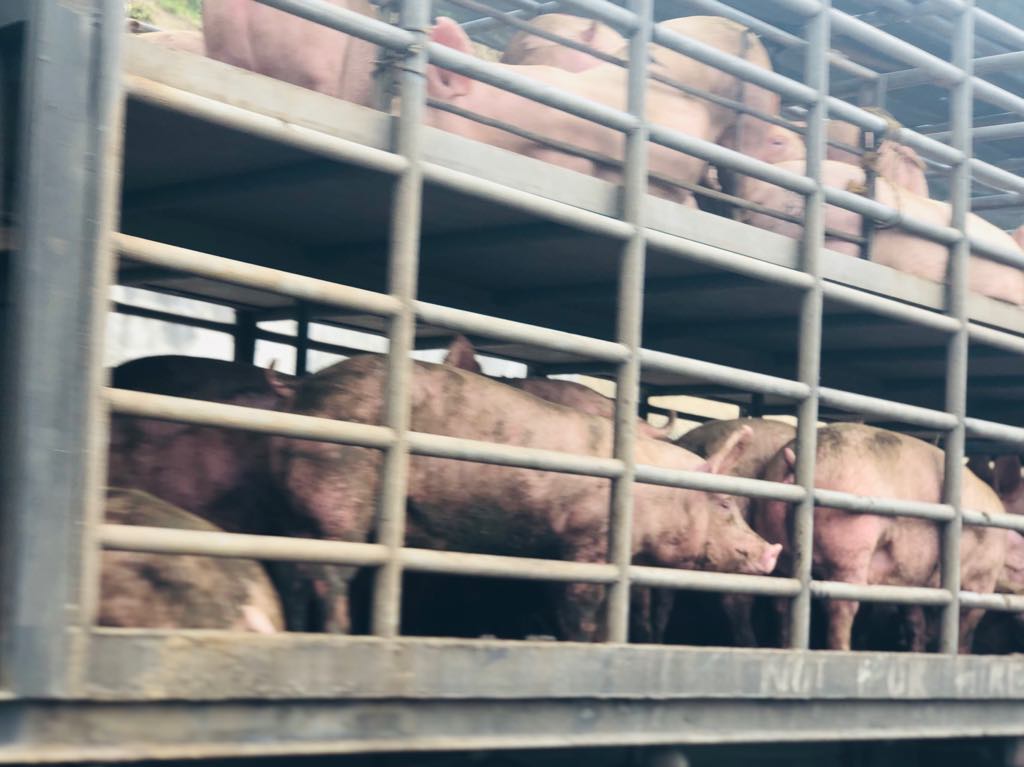Ma‚Äôam Malas jud, basin ma-impas ang baboy para sa bunyag naa daw African nga kalintura sa baboy!¬Ý
(Ma‚Äôam, it is unfortunate, the pig for my son‚Äôs baptism is might be gone, they say there is¬Ý¬ÝAfrican Fever among pigs)
This was the news our carpenter told me early Morning on Saturday, Jason Lee, 21, a young father, a resident of barangay Inayangan, Calinan District.
Their cherished two-month-old pig being grown for the baptism of their child will be among the hogs due for culling because African Swine Fever (ASF) virus has infected their their community and in Barangay Lamanan.
Jason Lee is just of one the dozens of backyard hog raisers in the region, his story might be immaterial to many but all hogs owners affected by the virus will have the same feeling of loss with the young father.
For big piggery owners, a pig which Jason Lee lost is just one, but for backyard hog raisers who took care of their animals in preparation for their children’s tuition fee or for the graduation, it is too much and too painful, but they need to live in a reality that ASF is a virus and every pig owner can be affected.
When I asked Jason, what is ASF or African Swine Fever, he answered, “kanang sakit sa baboy, didto ra man na sa Manila sauna (it is a disease among hogs, it was just in Manila before).

Jason explained, the feeds they give to their swine is from veterinary supplies and even expensive than the food they consume, he cannot believe that it will be infected, but when I explained to him the 1-7-10 protocol to contain the spread ASF, he was in deep sigh and told me in vernacular “If government will kill my pig, I have no choice, but as I understand it will not harm humans, but if its the only way to stop the virus—I have no choice, it is very unfortunate-the pig is not for my son’s baptism.”
Like Jason Lee, the recent cases in Davao City has caught authorities flat-footed because no one would believe, that the ASF virus in the municipalities of Don Marcelino and Malalag of Davao Occidental,will reach the city, given the strict order of Mayor Sara Duterte-Carpio prohibiting the entry of swine, processed meat and bi-products effective February 3, same day when the blood samples from swines in Dominga and Lamanan were taken by the Department of Agriculture and City Veterinarian, which yielded positive ASF virus.
Pinili in an interview with Newsline said they immediately sent a team to the barangays after they received reports on the death of pigs and hat the samples were taken on January 31 and February 3, on February 6, the laboratory examination conducted by the Bureau of Animal Industry (BAI) showed positive cases in both barangays.
Until now, no one can tell, how long will ASF virus live and up to where it can infect.

Understanding ASF:
Newsline talked with Dr. Jose Lorenzo M. “Ting” Gomos , Technical & Commercial Manager for Asia Andres Pinaluba , SA(Reus, Spain) –Animal Health & Nutrition, who presented a more detailed discussion about ASF in China and other parts of the world about the virus.
What is ASF?
It is a Highly contagious hemorrhagic viral disease of domestic and wild pigs of all ages
- ¬Ý‚Ä¢ Characterized by high fever, loss of appetite, reddening of the skin and hemorrhages of the internal organs, and death which follows between 2-10 days on the average¬Ý
- • Mortality can be as high as 100%
- ASF curable?
- – No treatment
- -No Vaccine Highly contagious
- ASF transmission:
- • Can be transmitted by direct contact:
- ¬Ý‚Ä¢ Infected pigs¬Ý
- ‚Ä¢ Ingestion of garbage/swill feeds containing unprocessed infected pig meat or pig meat products ‚Ä¢¬Ý
- Ticks and biting flies
- ¬Ý‚Ä¢ Contaminated premises, vehicles, equipment or clothing
Background • 1st case of African Swine Fever (ASF) in China reported on August 3, 2018 in the northeastern province of Liaoning • 2nd case reported in Henan province (August 14) • 3rd case reported in Jiangsu province (August 15) • 4th case reported in Zhejiang province (August 17) • 5th case reported in Auhui province (August 31) • As of date (December 12) – 104 outbreak
BABES
One of the measures that Gomos recommend is follow BAES;
- Ban pork imports- , etc¬Ý
- Avoid swill feeding
- ¬ÝBlock entry at international ports¬Ý
- Educate our people Submit¬Ý
- Samples¬Ý
- -Banning: Ban importation of domestic and wild pigs, their meat, meat products and by-products from ASF affected countries.
DA Memorandum Orders issued “Temporary Ban on the Importation of Domestic and Wild Pigs and their Products Including Pork Meat and Semen Originating from 13 countries: China, Hungary, Belgium, Latvia, Poland, Romania, Russia, Ukraine, Bulgaria, Czech Republic, Moldova, South Africa, and Zambia
-Advise swine raisers on the proper use of domestic food wastes swill feed for pigs
-Block the entry • Confiscation and condemnation of smuggled shipments • Strict screening and inspection of shipments and luggages from ASF affected countries • Strict Inspection of hand carried items and confiscation of items considered possible carrier of the virus • Proper Management of food wastes from international airports and seaports DA Memorandum Order No. 22 Series of 2018 “Prohibition on the Use of Catering Food Wastes/Left-overs from International and Domestic Airports and Seaports as Swine Swill Feed Throughout the Country
-Education • ASF Technical Advisory (released on August 31, 2018) • Consultative Meetings with different stakeholders • Information dissemination in collaboration with swine industry stakeholders
-Submit samples • We have trained laboratory personnel on ASF lab diagnosis • We have the laboratories supplies • Our lab personnel undergo regular proficiency testing • Test unusual sickness and mortalities
Food and other meat products coming from ASF-affected country: should be banned; meat must be cooked; All should have necessary permits/ clearances except for cooked Ban pork imports- , etc
Advise swine raisers on the proper use of domestic food wastes swill feed for pigs.
• African Swine Fever will be endemic in large parts of Asia • ASF is a very patient virus • Human attitude plays essential role in terms of control and in terms of spread • Key words: Transparency, honesty, communication, alertness and cooperation • Be very well prepared • Situation will have winners and losers
Why ASF usually affects small farm or backyard piggery?
Gomos explained ASF can be transmitted from a person who eats pork meat with ASF and the muna waste can be contribute especially if the toilet are not properly sealed or exposed to wind, wind can carry the virus present in human waste-it easily transmits.
“The lack Biosecurity in Backyard and Small Farms,” is a thing that matter. He added type of feeds, the Kind of Virus. ASF virus is one of the most stable and enduring virus in the world, it can stay alive in the soil for 5 years.
The virus can survive inside a can or inside a canned goods ( example Maling luncheon from China) because Canning or partial cooking) will NOT totally eliminate the Virus.
The virus can also survive several months in processed meat, and several years in frozen carcasses, so meat products are a particular concern for cross-border transmission. It is believed that the disease was initially brought from east Africa to Georgia by contaminated pig products.
In one instance, a packed of sausages confiscated at a Japanese airport from a traveller arriving from China were found to contain the virus. Similar discoveries have been made in South Korea, according to reports.
Leftover food collected from houses and restaurants with meat contaminated with ASF are considered free carrier especially is it is feed to the swine. No feeding of Swill feed/ Human food refuse,
Meat products should be deep fried.
Key Actions
1. Network of mobile vets field teams.
➢ Sanitary control of holdings ➢ Animal identification ➢ Epidemiological surveys ➢ Samples collection➢ Samples collection ➢ Serological control at abattoirs ➢ Epidemiological investigations ➢ Promotions of SanitaryAssociations* *ADS: Asociación de Defensa Sanitaria (Animal Health ProtectionAsociation)
2. Serological surveillance of 100% of pig farms
Main needs: ‚û¢ Asimple, fast, accurate & specific diagnostic test (Indirect ELISA) ‚û¢ A Reference Laboratory to harmonize the techniques (CISA-INIA) ‚û¢ Anet of Regional Laboratories for serological surveillance (13 labs) At the begining: Indirect ELISA to screen samples ; IFA to confirm results In the final stages: INIAdeveloped and improved ELISA (new solubleAg with allASFV proteins); INIAdeveloped Immunoblotting assay as confirmatory instead of IFA
3. Improvement in animal holding facilities
First objective: to improve sanitary barriers to prevent de spread of the disease Hygiene measures: fences, sanitary enclosures, safe disposal of manure…
4. Elimination of allASF outbreaks
(stamping out) ‚û¢ All pigs in infected herds immediately slaughtered ‚û¢ Samples collection for virological & epidemiological investigations ‚û¢ Immediate and adequate compensation to the pig producers
STAMPING OUT must be:¬Ý‚úì¬ÝApplied for a period long enough to eradicate¬Ý‚úì¬ÝAccompanied by public awareness campaigns Procedures once out.

Procedures once outbreak identified
‚úì Depopulation by slaugthering all pigs in the affected herd ‚úì Cleaning and disinfection of all facilities during 1 month after depopulation ‚úì Extermination of insects and rodents ‚úì Removal and destruction of all animal feed and animal products ‚úì Cleansing of manure pits by 2% sodium hydroxide ‚úì Incineration of straw bedding ‚úì Sanitary zone of a few hundred km radius ‚úì Movement of animals, products, feed and waste into or out the sanitary zone were restricted ‚úìMovement of people to and from the area were restricted ‚úìAfter implementation measures were gradually lifted (although some specific were maintainedat least 3 months)
Procedures once outbreak identified
✓ After cleaning and disinfection, introduction of sero- sentinels ✓ Number of sentinels equivalent to 10-20% of the population ✓ If after 1 month don’t become sick: serological test ✓ If –, authorities allow the repopulation of farm (from status controlled farm) ✓ Restocking procedures usually completed within 3 months after entry of sentinels
Transmission between herds:
Biosafety and sanitary measures to avoid transmission between herds played an important role in the eradication Epidemiological surveys indicated that 84% in 1989 and 93% in 1990, neighbor contacts as the most likely source of the new outbreaks.
Restricted Areas¬Ý‚úì¬Ý3 km radius¬Ý‚úì¬ÝAll pigs of all herds serologicallly screened immediately after confirmation¬Ý‚úì¬ÝMovement prohibited for 30 days q Protection zone q Surveillance zone¬Ý‚úì¬Ý10 km radius¬Ý‚úì¬ÝScreening 30 days after cleaning & disinfection of infected holding¬Ý‚úì¬ÝMovement prohibited for 30 days.
Movement of animals:
‚úì Vehicles required to be washed and disinfected ‚úì Animals in transit previously identified & provided with veterinary certificate (stating origin & sanitary situation) Abattoir ‚úì Vets checking the sanitary certificate (before slaughtering) ‚úì Life pigs inspected antemortem & tissues posmortem ‚úì Sanitary certificates retained at least 1 year ‚úì Manufacturers retained identification of meat origin
Spain is the first country in the world who was able to eliminate the disease after it hit the in the 1990’’s.
On Friday, February 7
President Rodrigo Duterte has ordered all government agencies and local government units to comply with the national zoning plan for African swine fever, which aims to control the spread of the fatal hog disease through dministrative Order No. 22, which emphasized the need to comply with the zoning plan included in the Department of Agriculture’s Administrative Circular No. 12 to control the spread of the hog disease.
The DA issued the zoning plan in December 2019 as one of the key measures to eradicate ASF, which struck hog farms mostly in Luzon.
Under the agriculture department’s circular, zones will be established across the country to protect areas unaffected by the hog disease and limit the spread in those with confirmed ASF cases.
To ensure compliance, Duterte ordered the DA, Department of Trade and Industry, and the Department of the Interior and Local Government to monitor adherence to the zoning plan.
The Philippines confirmed its first case of ASF in September 2019, prompting a ban on meat products from countries where the hog disease was first reported.
The outbreak was first confirmed in hog farms in Luzon, where thousands of pigs have been culled to contain the disease.
In November, the agriculture department said the local outbreak was caused by smuggled pork products from China.
With all these key factors, Gomos emphasized ‚ÄúA good local formula in¬Ý¬Ýformula of addressing the problem with the strict community approach will mean success in addressing the problem.‚Äù-Editha Z. Caduaya
- Sources:¬Ý
- -Dr. Jose Lorenzo M. “Ting” Gomos , Technical & Commercial Manager for Asia Andres Pinaluba , SA(Reus, Spain) –Animal Health & Nutrition
- He is a member of AASV ( American Association of Swine Veterinarians )
- -Maria Glofezita O. Lagayan-¬Ý¬ÝBureau of Animal Industry, Department of Agriculture
- -Adrian Balaban, veterinarian, Romania¬Ý
- • Anne-Marie van der Linde-Teunishen, Boerderij, the Netherlands
